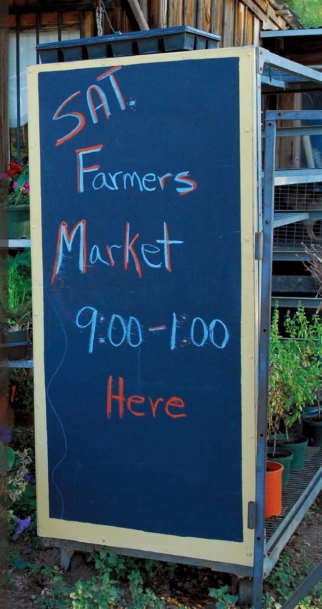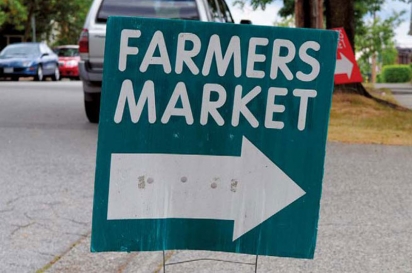Farmers' Markets: Bringing Food to the People
“What’s your favorite vegetable?” asked the Hartford Courant reporter. “Pork chops,” replied the farmer.
That’s how the opening exchange went between the press and a Hartford area farmer on the first day of the first farmers’ market in Connecticut since World War II. That the market’s organizer, Sally Taylor, had not rehearsed these pioneer farmers for their public debut was not her fault. The simple fact that nearly twenty Connecticut River Valley growers had circled their hodgepodge assortment of trucks and vans around the city’s Old State House was a miracle. It had required months of detailed planning and delicate negotiations with skeptical city officials. Hardest of all had been the careful and extensive outreach to the region’s farmers, whose initial response to the idea of an urban farmers’ market ranged from a monosyllabic grunt to stone silence.
The chaotic street scene that unfolded on that July day in 1978 belied the deliberate behind-the-scenes orchestration that had been necessary to bring this dream to fruition. Hartford residents and downtown office workers had been forewarned with leaflets and press releases, but no one had quite imagined the disheveled band of country folk who would appear on their doorstep to hawk their wares. The farmers were backing their trucks up to the curbs in their preassigned spots, just as planned. Signs and banners had been dutifully placed to secure maximum exposure but avoid offending the city’s insurance executives. The city’s police officers, with their squad cars’ cherry tops spinning, were there to direct traffic and protect the public safety, just in case the pent-up passion for fresh vegetables erupted into violence.
The presence of the local constabulary heightened the drama. Is someone famous coming to town? Is there an office tower fire? Where’s the bank robbery? These were just some of the questions coming from would-be customers starting to close in on the scene. With a sense of heightened expectation, the number of people began to swell, seduced perhaps by the heavy scent of fresh peaches, just-picked corn, and brilliantly colored flowers. People who had rarely seen, smelled, or tasted local produce found themselves caught up in the gawking crowd. They would soon engulf the hapless farmers, who took to defending their rickety card tables like soldiers on an embattled perimeter. As a group that generally avoided Hartford at all costs, the farmers found their pockets swelling with cash in direct proportion to their dwindling supply of produce.
Farmers’ markets started popping up across America in the mid-1970s. Los Angeles, Santa Fe, and New York City were among the early entries as consumers began to rediscover the taste and price value of locally produced food. For Hartford, farmers’ markets were a part of the original Hartford Food System game plan, a non-profit organization that was one of the first in the nation to take up the challenge of creating a seed to table approach to the regions food, nutrition, and agriculture problems. The organization’s hope for farmers’ market was that they would connect local farmers and urban consumers, especially lower-income families, for both groups’ mutual benefit.
Farmers’ Markets Experience a Growth Spurt
Fast-forward thirty years, and the number of farmers’ markets nationwide has swollen to almost 4,500. The USDA estimates that between 30,000 and 50,000 farmers currently sell at farmers’ markets. They are one of the most important factors in the tidal wave of interest in local food and the mini-revival of small farms.
The Greenmarkets of New York City, made famous by John McPhee’s 1970s New Yorker story “Giving Good Weight,” had the biggest impact on the early explosion of farmers’ markets. The Greenmarkets served as an inspiration and model for market aficionados everywhere, including those in Hartford. The name itself became synonymous with freshness, local farming, and vibrant outdoor markets.
Despite the Greenmarkets’ eventual success, the challenges that early organizers faced were enormous. They included finding acceptable sites, securing permission to use the sites (then retaining that permission for more than one year), recruiting farmers (some coming from as far away as two hundred miles), getting parking permits, towing cars, and dealing with the Gordian knot of New York City’s bureaucracy. By 1981, however, New York City had sixteen farmers’ markets and had spawned several others outside the city.
The essential determinant of success for any market was usually what worked best for the farmers—where they would make the most money and encounter the fewest hassles. In some cases, market sites were selected to meet the needs of a particular community and to serve mixed-income shoppers, but increasingly farmers followed the gravitational pull exerted by higher-income shoppers. As the saying went: no money, no farmers; no farmers, no market.
How do you make farmers’ markets work for low-income shoppers— offering them affordable fresh produce at convenient locations—?
Where the focus had been exclusively on securing the best return for farmers, markets rarely provided a good food-shopping opportunity for low-income people, because the food was priced too high and the location was not accessible. When markets had been located exclusively to fit the needs of low-income communities, they rarely attracted sufficient farmers to be successful.
New Orleans Farmers’ Markets Show the Way
The struggle for farmers’ markets to help close the food gap would be played out almost every time a new market opened. Even when markets were so successful that it seemed there was no room for improvement, a small voice in the back of the room would ask why there weren’t more people of color shopping there, or why residents from the nearby low-income neighborhood weren’t coming to the market. The answer came as market organizers learned the art of collaboration.
In that vein, farmers’ market leaders such as Richard McCarthy of New Orleans could sustain the value of a farmers’ market without straining its capacity to deliver a wide range of benefits to a diverse number of people.
McCarthy, age forty-two, utters perfectly constructed sentences that are woven into equally fluent paragraphs and are spiced discreetly with the vocabulary of New Left politics. He has a well-formed theory of change that surgically dissects the failures of globalism and free market capitalism. He’s scraped his knees on the rough ground of Old South politics, racism, and a city that is struggling to revive after the hellfire of Hurricane Katrina. Though McCarthy can hold forth with ease on the tenets of Marxism, he prefers the simple pleasures of helping to restore people’s pride in their place, heritage, and food.
In 1995, McCarthy led the way in the establishment of the Crescent City Farmers’ Market, which would become home to sixty Louisiana farmers grossing $2 million a year. Once he figured out how to organize the market correctly, he passed the wisdom on to other groups, which then started twelve additional markets in the region. City consumers, chefs, and a generous slice of the Big Easy’s bon vivant class, began to see their fates intertwined with that of the farmers, who in turn, like farmers in Connecticut, were struggling to survive the changes in the food marketing and distribution systems.
McCarthy saw that New Orleans’s survival depended in large part on the vitality of its food culture, so he organized the market as a creative economic engine that would channel the city’s unique heritage in music, food, and conviviality. But along the way, he kept his feet on the ground so as not to leave the city’s large low-income population behind. Job creation at all levels of the food chain and some food processing businesses, such as a neighborhood-based pasta company, were all part of the mix.
He built trust among farmers who had previously resisted coming to New Orleans without a gun because of the city’s reputation as the murder capital of America. He shored up the confidence of a welfare mother who didn’t believe she had what it takes to start and run her own business. And, most important for low-income consumers, he was able to secure $100,000 annually in Farmers’ Market Nutrition Program (FMNP) funds that provided a powerful incentive to thousands of low-income households to shop at the farmers’ market.
A Maturing Presence and a Growing Commitment
Steady growth in the number of farmers’ markets continues. Although their outsized presence is due more to their visibility than to their share of the U.S. food market—farmers’ market annual sales represent less than 1 percent of retail food dollars—their impact on today’s food consciousness is undeniable. According to the Project for Public Spaces, almost two-thirds of all farmers’ markets are located in downtown areas. More than one-third are sponsored by local government, which is a testament to their elevated standing as local economic and tourist attraction engines. While their commitment to serving all income groups is not universal, almost two-thirds of the markets participate in the FMNP, which provides special vouchers to low-income families to purchase fresh produce at farmers’ markets. And increasingly they are deploying technology that enables them to also accept food stamps.
America’s food consciousness was aroused from a deep slumber in the late 1960s. By the 1970s, hippies, health nuts, and overeducated young people, including myself, had developed an uneasy sensation that there was something wrong with our food system. This growing awareness incited a kind of disorganized guerrilla warfare that sent an ever-increasing number of insurgents into food co-ops, organic farms, and communes. While these early skirmishes probably inflicted more damage on the guerrillas than they did on their ill-defined enemy, they also produced a small class of skilled organizers and leaders capable of taking the struggle to a higher level. And in the battles to come, it was farmers’ market organizing that established the first successful beachhead in the fight to overhaul the food system and close the food gap.
Adapted from Closing the Food Gap: Resetting the Table in the Land of Plenty by Mark Winne Copyright © 2008 by Mark Winne. By permission of Beacon Press, beacon.org.
For twenty-five years Mark Winne was the executive director of the Hartford Food System in Hartford, Connecticut. He now writes, speaks, and consults extensively on community food system topics. Winne lives in Santa Fe, New Mexico. Read more about Mark’s work at markwinne.com






